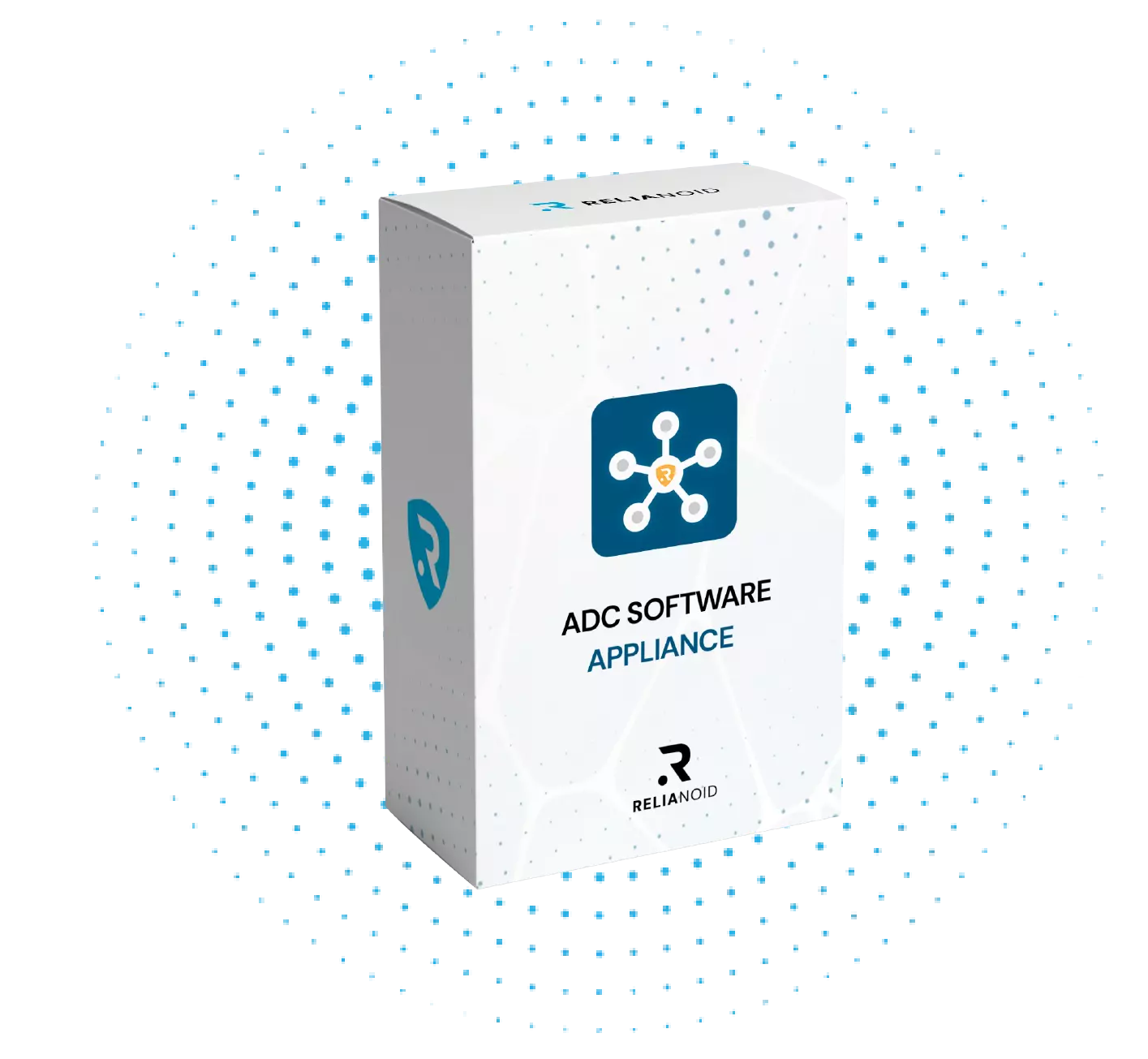Baremetal Load Balancer Appliance
Load Balancer ready to be installed in baremetal multivendor servers
Whats included in RELIANOID Baremetal Load Balancer?
Designed to elevate your online services to unparalleled levels of performance, reliability, and security,
our ADC solution ensures seamless traffic distribution, load balancing, enhanced resource utilization,
and fortified protection against potential cyber threats.
Easy to Use
Providing you massive scalability, high availability and increased security for your services, applications, and networks.
Powerful Hardware
Unlimited throughput, connections, farms, and optimized for multi-core with broad hardware compatibility.
Easy Deployment
No need for installation that allows a quick production consolidation, ensuring a seamless deployment process.
Ready to-go
Integrated easily in your infrastructure ensuring a productive and cost-saving setup and maintenance.
Multi Hypervisor
Broad multi-vendor hypervisor platforms such as VMware ESXi, Workstation, Hyper-V, Xen, KVM, Proxmox and more.
Cost-Efficient
Sharing hardware resources reduces costs associated with physical hardware, making it a budget-friendly option.
Load Balancer baremetal Performance
System Specifications
Multilayered Application Delivery Controller
A comprehensive Application Delivery Controller solution designed to serve as a flexible and highly available Baremetal Load Balancer. It supports multilevel functionality across L2, L3, L4, and L7, allowing different load balancing methods such as SD-WAN, network load balancing, application load balancing and global service load balancing. Designed for optimal traffic management, robust application delivery, and seamless scalability in on-premises, cloud or hybrid environments.
Optimized and limitless system
The RSA series are optimized Linux networking systems without restrictions in terms of the number of cores, memory used, throughput or other system parameters. Get all the features and the maximum settings from the system with every upgrade!
RELIANOID Enterprise Edition v8
Featuring the latest stable version of RELIANOID’s Enterprise Edition, this Baremetal Load Balancer includes enterprise-grade performance improvements, enhanced security features, usability refinements, and advanced management capabilities, making it ideal for any demanding workloads.
Responsive Web and Command Line Interfaces
Web graphic user interfaces with improved usability, accessibility and responsive view to be used in different devices.
Rest Json API v4
Load balancing automation is possible with a REST JSON API to view, create, delete and modify resources in the load balancer: farms, backends, farm guardian, statistics, network interfaces and more.
Limitless system
The RSA series are not limited in CPU usage, CPU cores, maximum bandwidth, number of farms or backends. You get the full features and the maximum settings from the system with every product! Use all the resources available without restrictions in terms of the number of cores, memory used, throughput or other system parameters.
Optimized for Virtual Platforms
Support of optimized drivers and systems to gather better performance in the most used virtualized platforms like Vmware ESXi, Hyper-V, Xen Server, and KVM.
Optimized for multi-core hardware vendors
Support of a broad set of drivers to be able to transform your hardware server in a complete ADC ready to be installed in multi vendors servers and optimized for multi-core processors.
Features
Multi-Layer Load Balancing
Supports L2, L3, L4, and L7 load balancing for seamless traffic management across WAN, applications, data centers, and services.
Broad Protocol Compatibility
Works with major protocols (TCP, UDP, HTTP, HTTPS, DNS, etc.) and applications like MS Exchange, Citrix, and Lync.
High-Performance Proxy
Includes HTTP/2 support and hot restart for uninterrupted sessions.
Advanced HTTP/HTTPS Features
Offers session persistence, SSL certificates, reverse proxy, and other features for secure and efficient app delivery.
Intelligent Health Checks & Scalability
Monitors server health and balances traffic using algorithms like round robin, CPU load, and least connections.
Disaster Recovery & High Availability
Configuration backups and active-passive stateful clustering ensure high availability.
Comprehensive Monitoring
Real-time service monitoring with alert notifications via email and SNMP for proactive management.
Advanced Network Management
Supports VLANs, virtual IPs, link aggregation, IPv6, VPN services with IPsec, and NAT/DSR topologies for complex network configurations.
Automation & Security Compliance
REST+JSON API for automation, SSL Labs A+, PCI DSS, DORA and HIPAA compliance.
Integrated IPS Security Module
Features a Web Application Firewall, local and remote blacklists, DNS-based blackhole lists (DNSBL), and DDoS protection to safeguard on-premises or cloud hosted applications.
MFA Support
High performance for scalable baremetal load balancer deployments with multi-factor authentication integration for web applications.
Requirements
Network Interface Configuration
Minimum of one Network Interface Card (NIC) is required, with two recommended—one dedicated for administration purposes and another for production services. This configuration ensures optimized performance and security for the Baremetal Load Balancer.
Platform Selection
Any version of VMware ESXi, Hyper-V, Xen Server, KVM, AWS, Azure, GCP or OEM hardware is supported as system platform for Baremetal Load Balancing.
Resource Allocation
Adequate allocation of CPU and memory resources to support the intended traffic and application demands, ensuring the Baremetal Load Balancer operates effectively under various load conditions. The usage of dedicated cores are recommended and a minimum of 20 GB of disk.
Security Groups and Network ACLs
Configure appropriate security groups and network access control lists (ACLs) to restrict access and enhance security for the Baremetal Load Balancer.
Licensing
The software included in the RSA Enterprise Edition is provided under the terms of the GNU Affero General Public License v3.
The licensing model for RSA products is tied to the number of instances deployed. Therefore, the number of appliance licenses required corresponds directly to the number of deployments, regardless of resource allocation such as CPU, memory, or throughput per instance.
If only a single node is necessary, you will need to purchase one appliance license. However, if a clustered load balancing service is required, you will need two appliance licenses.
Each appliance can be updated and upgrade to a major release with incremental software releases provided through a valid Support Plan with a simple update procedure.
Additionally, redeployment during the appliance’s lifecycle is permitted as long as the hostname remains unchanged. If you need to change the hostname of the appliance without a related redeployment, an appliance certificate can be reissued.
FAQs
How Does the Evaluation Work?
The evaluation of this product is free and allows you to deploy, create, and utilize the full version for one month by default. If you need an extension beyond this period, you can request it to our Sales Team. During the evaluation phase, free pre-sales support is available. Once you’ve decided to make a purchase, you simply need to obtain a definitive activation certificate without redeploying the appliance.
How to Upgrade from Community to Enterprise Edition?
Seamless upgrade from Community to Enterprise Edition is fully supported without redeploying the appliances and required migration of configuration files are automatically performed. Contact with our Team for more information.
How Many Licenses Are Needed to Build a Cluster?
To build a cluster and achieve high availability (HA), you will need to acquire two licenses with the same Support Level.
The RELIANOID cluster operates as a stateful cluster, meaning that if the primary node goes down, the second node automatically takes over without any disruption to clients. This functionality is possible because the second node continuously synchronizes configurations, automatic processes, connections, and user sessions, ensuring both nodes remain online at all times. This setup allows for a quick switch between nodes.
Is Support Included with the Appliance?
Support services are not included with the appliance and must be purchased separately to receive updates, security advisories, patches, hotfixes, and assistance from our specialized Support Team. We offer three different support plans tailored to various application requirements, ranging from updates-only options to 24×7 support services. First year of support will be mandatory.
Are Disaster Recovery and Development licenses available?
Yes, we offer special licenses for Disaster Recovery and Development purposes. Please reach out to our Sales Team for more information.
 RSA8000 RELIANOID Software Appliance Datasheet
RSA8000 RELIANOID Software Appliance Datasheet
(updated December, 2024)
Built for Hybrid Infrastructure
Our Baremetal Load Balancer solution is designed to integrate seamlessly with on-premises, cloud or hybrid environments. It provides automated traffic distribution, fast deployment, and scalability for any kind of environments, ensuring smooth operation for enterprises of all sizes.
Benefits of using RELIANOID Baremetal Load Balancer
The Baremetal Load Balancer from RELIANOID provides high availability and resilience, ensuring continuous service even under heavy traffic conditions, thanks to its built-in redundancy. It automatically scales to meet fluctuating demands, allowing your virtual machines to handle traffic spikes without sacrificing performance. With integrated security features, your infrastructure is protected from potential threats, ensuring the safety of your applications and data.
This solution also enhances performance by intelligently routing traffic, reducing latency, and optimizing resource utilization. Additionally, the Baremetal Load Balancer is cost-efficient, enabling you to reduce operational expenses while maintaining high-performance levels, making it an ideal choice for businesses looking to optimize their on-premises or cloud infrastructure.
Integration with Hybrid Infrastructure
Our Baremetal Load Balancer Appliance integrates seamlessly with OEM, virtual, on-premises, cloud or hybrid environments, ensuring comprehensive traffic management and performance optimization across your networks, servers and applications.
Virtual Templates
Efficiently balances traffic across VMware ESXi, Xen Server, Hyper-V, KVM, etc virtual machines, ensuring high availability and performance for your virtualized applications.
Baremetal ISO
Fully compatible with generic drivers ready to be installed in any OEM multi-vendor hardware appliance for enhanced networking and security features, providing optimized load balancing and traffic management.
Cloud BYOL
Seamless integration with AWS, Azure and GCP for load balancing across cloud servers and applications.
Use cases for Baremetal Load Balancer
Load Balancing Applications
Optimally balances traffic across on-premises or cloud applications, ensuring smooth performance and efficient resource distribution for business-critical applications.
Enterprise Workloads
Enhances performance and availability for mission-critical business applications hosted in on-premises or cloud environments, ensuring uninterrupted service.
Disaster Recovery
Supports software-based disaster recovery solutions by efficiently distributing traffic during failover processes, improving recovery times and data availability.
Cloud-based Deployments
Facilitates efficient traffic distribution for application workloads deployed in hybrid or cloud environments, ensuring scalable and reliable performance across multiple locations.
Get Started with RELIANOID Baremetal Load Balancer
Ready to optimize your infrastructure with Baremetal Load Balancer? Contact us today to discover how RELIANOID’s solution can enhance your data-center environment, providing unmatched reliability, security, and scalability for your application workloads and services.
WAYS TO
GET STARTED








